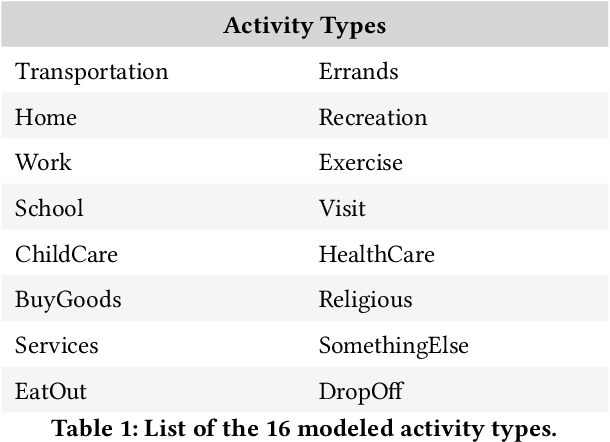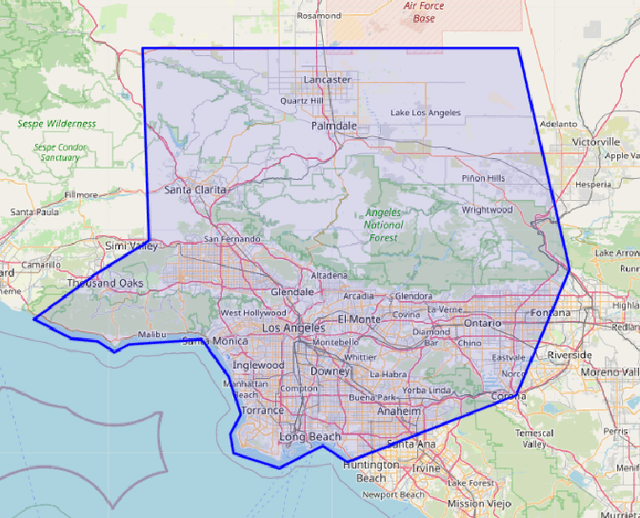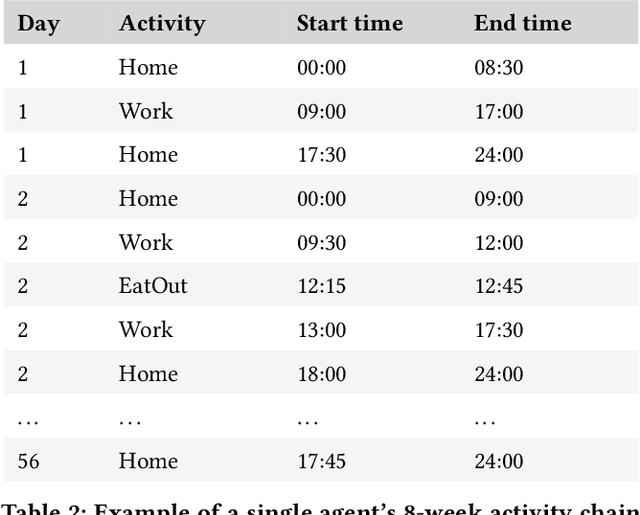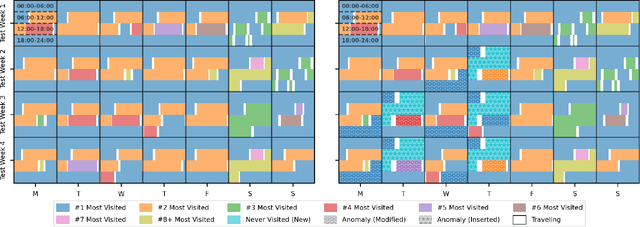Chris Stanford
MobiFuse: Learning Universal Human Mobility Patterns through Cross-domain Data Fusion
Mar 20, 2025Abstract:Human mobility modeling is critical for urban planning and transportation management, yet existing datasets often lack the resolution and semantic richness required for comprehensive analysis. To address this, we proposed a cross-domain data fusion framework that integrates multi-modal data of distinct nature and spatio-temporal resolution, including geographical, mobility, socio-demographic, and traffic information, to construct a privacy-preserving and semantically enriched human travel trajectory dataset. This framework is demonstrated through two case studies in Los Angeles (LA) and Egypt, where a domain adaptation algorithm ensures its transferability across diverse urban contexts. Quantitative evaluation shows that the generated synthetic dataset accurately reproduces mobility patterns observed in empirical data. Moreover, large-scale traffic simulations for LA County based on the generated synthetic demand align well with observed traffic. On California's I-405 corridor, the simulation yields a Mean Absolute Percentage Error of 5.85% for traffic volume and 4.36% for speed compared to Caltrans PeMS observations.
Reconstructing Human Mobility Pattern: A Semi-Supervised Approach for Cross-Dataset Transfer Learning
Oct 03, 2024



Abstract:Understanding human mobility patterns is crucial for urban planning, transportation management, and public health. This study tackles two primary challenges in the field: the reliance on trajectory data, which often fails to capture the semantic interdependencies of activities, and the inherent incompleteness of real-world trajectory data. We have developed a model that reconstructs and learns human mobility patterns by focusing on semantic activity chains. We introduce a semi-supervised iterative transfer learning algorithm to adapt models to diverse geographical contexts and address data scarcity. Our model is validated using comprehensive datasets from the United States, where it effectively reconstructs activity chains and generates high-quality synthetic mobility data, achieving a low Jensen-Shannon Divergence (JSD) value of 0.001, indicating a close similarity between synthetic and real data. Additionally, sparse GPS data from Egypt is used to evaluate the transfer learning algorithm, demonstrating successful adaptation of US mobility patterns to Egyptian contexts, achieving a 64\% of increase in similarity, i.e., a JSD reduction from 0.09 to 0.03. This mobility reconstruction model and the associated transfer learning algorithm show significant potential for global human mobility modeling studies, enabling policymakers and researchers to design more effective and culturally tailored transportation solutions.
Human Mobility Modeling with Limited Information via Large Language Models
Sep 26, 2024



Abstract:Understanding human mobility patterns has traditionally been a complex challenge in transportation modeling. Due to the difficulties in obtaining high-quality training datasets across diverse locations, conventional activity-based models and learning-based human mobility modeling algorithms are particularly limited by the availability and quality of datasets. Furthermore, current research mainly focuses on the spatial-temporal travel pattern but lacks an understanding of the semantic information between activities, which is crucial for modeling the interdependence between activities. In this paper, we propose an innovative Large Language Model (LLM) empowered human mobility modeling framework. Our proposed approach significantly reduces the reliance on detailed human mobility statistical data, utilizing basic socio-demographic information of individuals to generate their daily mobility patterns. We have validated our results using the NHTS and SCAG-ABM datasets, demonstrating the effective modeling of mobility patterns and the strong adaptability of our framework across various geographic locations.
NUMOSIM: A Synthetic Mobility Dataset with Anomaly Detection Benchmarks
Sep 04, 2024



Abstract:Collecting real-world mobility data is challenging. It is often fraught with privacy concerns, logistical difficulties, and inherent biases. Moreover, accurately annotating anomalies in large-scale data is nearly impossible, as it demands meticulous effort to distinguish subtle and complex patterns. These challenges significantly impede progress in geospatial anomaly detection research by restricting access to reliable data and complicating the rigorous evaluation, comparison, and benchmarking of methodologies. To address these limitations, we introduce a synthetic mobility dataset, NUMOSIM, that provides a controlled, ethical, and diverse environment for benchmarking anomaly detection techniques. NUMOSIM simulates a wide array of realistic mobility scenarios, encompassing both typical and anomalous behaviours, generated through advanced deep learning models trained on real mobility data. This approach allows NUMOSIM to accurately replicate the complexities of real-world movement patterns while strategically injecting anomalies to challenge and evaluate detection algorithms based on how effectively they capture the interplay between demographic, geospatial, and temporal factors. Our goal is to advance geospatial mobility analysis by offering a realistic benchmark for improving anomaly detection and mobility modeling techniques. To support this, we provide open access to the NUMOSIM dataset, along with comprehensive documentation, evaluation metrics, and benchmark results.
 Add to Chrome
Add to Chrome Add to Firefox
Add to Firefox Add to Edge
Add to Edge